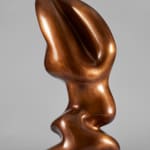



Hans (Jean) ARP French, 1886-1966
87.9 x 40 x 35.9 cm
Further images
Jean Arp, a sculptor, painter, and poet, is incontestably one of the pillars of Modernism. He co-founded the Dada movement in Zurich in 1916 and later became associated with Surrealism. He was a strong influence on other artists from the 1930s on, including Kandinsky, Mondrian, Picasso, Duchamp, Klee, Schwitters, Janco, Breton, and Tristan Tzara, with whom he remained closely associated.
Arp's international career took off in 1950; his first solo exhibition had been held the preceding year, organized by Curt Valentin at the Buchholz Gallery in New York. It was a period of effervescent creativity for Arp as a sculptor, and it led to his world-wide success. A few years later, in 1954, he was awarded the Grand Prize for sculpture at the Venice Biennale, and in the ensuing years, he was commissioned for many projects and was the subject of international exhibitions, perhaps most notably, a major retrospective at MoMA in 1958.
In the sculpture Planzengriffe (Pistil), Arp has brought together the characteristic elements of his work. He modeled the work on an organic form, conforming to his interest in imbuing his sculptures with the metamorphoses of the natural world. The key theme of these metamorphoses, the cycle of life, is represented here by the pistil, the female reproductive organ of a flower, an original vegetal form, a source of life.
Arp's association with the Dada movement and the Surrealists in the 1920s reinforced the artist's abstract tendencies: "How difficult it is to make it understood that to love someone is not necessarily to sculpt their image, make their portrait as has been done for centuries, but to allow a man to realize his dream like a plant produces a flower." (Jean Arp, "Antoine Poncet", in Carreau, March, 1955, Lausanne).
He used an oval in order to get closer to a universal creative form and lean toward a verticality that he described as aiming at infinity. "I model fruits that lie still, clouds that drift on and up, stars that grow ripe and drop, symbols of the eternal transformation into infinite space." (Jean Arp, "The Inner Language", in M. Jean, ed., Arp: Collected French Writings, 1974, London, p. 292).
The organic voluptuousness of this sculpture, so full of life, so spontaneously expansive, suggesting a motion surprised by its intrinsic energy—these qualities are all emphasized by the high polish of the sculpture, reflecting its environment.
For Arp, bronze was a material for perfection. It guaranteed the exact transcription of a plaster original into a durable form, allowing him to achieve works as "perfect" as he had conceived them.
Provenance
Basel, Galerie d’Art Moderne
Paris, Galerie Albert Loeb
Boris Leavitt collection, acquired in 1961
Christie’s New York, 14th November 1996, lot 220, « Property from the Collection of Boris Leavitt »
William Rubin collection, New York, former director of the MoMA
Private collection, Switzerland
Literature
- Arie Hartog, Kai Fischer, Hans Arp, Sculptures, a Critical Survey, Hatje Cantz Verlag, 2012, no. 108, p. 108, p. 283, illustrated
- Ionel Jianou, Jean Arp, Paris, 1973, p. 72
- Serge Fauchereau, Arp, Paris 1988, p. 75




